Simply creating a poll to see how much life everyone has been getting out of their stock clutch before experiencing failure.

21 - 30 of 30 Posts
Joined
·
280 Posts
Oh i get it man. Really doThis is literally the most chewed topic on this bike.
Clutch is completely fine and nothing was wrong in the orignal model as well. Me being on one and having 15k km's can confirm 0 problems & know alot of others locally and from this forum over 40 and 50k who never had an issue as well. It's all about how you ride! If you trashing it every stop light, you obviously cant change at the required sensitivity, therefore you will eventually mess up your clutch, clean cut and dry....
all about riding habits with this.
I have to ask... why did Kawasaki update the clutch pull rod on the 2020 model if there was nothing wrong with the original model (2018, 2019)?Clutch is completely fine and nothing was wrong in the orignal model as well. Me being on one and having 15k km's can confirm 0 problems & know alot of others locally and from this forum over 40 and 50k who never had an issue as well. It's all about how you ride! If you trashing it every stop light, you obviously cant change at the required sensitivity, therefore you will eventually mess up your clutch, clean cut and dry....
The part numbers are different starting in 2020, going from 46102 to 46102A or 46102-0573 to 46102-0648.
See this thread for reference Barnett clutch and springs
or check an online parts diagram and note the appearance of 46102A for 2020 model year. For example: 2020 Kawasaki Ninja 400 (EX400HLF) Clutch | CyclePartsNation Kawasaki Parts Nation
Joined
·
798 Posts
Yeah they updated it. Not because something is wrong, but rather the average rider who goes up on this bike launches himself like he's in a formula 1 race (most riders honestly, nothing special on this bike). However, giving the soft clutch springs (If I am not mistaken, this clutch is exactly the same from the 300) which are not entirely fitted to the 400's power, slippage can happen and probably will occour when you switch gears in the higher rev range while launching off from a stop like you are drag racing, and none really can shift gears properly with the required attention on the lever while doing so.I have to ask... why did Kawasaki update the clutch pull rod on the 2020 model if there was nothing wrong with the original model (2018, 2019)?
The part numbers are different starting in 2020, going from 46102 to 46102A or 46102-0573 to 46102-0648.
See this thread for reference Barnett clutch and springs
or check an online parts diagram and note the appearance of 46102A for 2020 model year. For example: 2020 Kawasaki Ninja 400 (EX400HLF) Clutch | CyclePartsNation Kawasaki Parts Nation
If there was really something wrong, they would have gone for a recall. They didn't. Combining the fact the the average / newbie rider don't really know how to set up the clutch lever properly and launches from every stop x4 times the speed of a regular car like they are evading the popos, you will be messing up the clutch. Don't blame Kawi for it. They did make a change to make it happen 'less' but those are still the same components.
The fact remains, there is probably thousands of riders on 400 out there with thousands of kilometers on the clock who never had any issue nor messed with it.
Reminds me one time, I came to a stop next to two guys with open windows in their car. They look at me and say that one of them had a 400 and after 1000 km's the clutch went bad.
It's not a disease, stupid 🤓
Joined
·
1,801 Posts
They updated it because there is a design flaw.Yeah they updated it. Not because something is wrong, but rather the average rider who goes up on this bike launches himself like he's in a formula 1 race (most riders honestly, nothing special on this bike). However, giving the soft clutch springs (If I am not mistaken, this clutch is exactly the same from the 300) which are not entirely fitted to the 400's power, slippage can happen and probably will occour when you switch gears in the higher rev range while launching off from a stop like you are drag racing, and none really can shift gears properly with the required attention on the lever while doing so.
If there was really something wrong, they would have gone for a recall. They didn't. Combining the fact the the average / newbie rider don't really know how to set up the clutch lever properly and launches from every stop x4 times the speed of a regular car like they are evading the popos, you will be messing up the clutch. Don't blame Kawi for it. They did make a change to make it happen 'less' but those are still the same components.
The fact remains, there is probably thousands of riders on 400 out there with thousands of kilometers on the clock who never had any issue nor messed with it.
Reminds me one time, I came to a stop next to two guys with open windows in their car. They look at me and say that one of them had a 400 and after 1000 km's the clutch went bad.
It's not a disease, stupid 🤓
Norton write up below:
Problem #1, My clutch is slipping when I accelerate!
- Solution for OEM clutch: Install Heavy Duty Barnett Clutch Springs and Friction Plates, Ninja400R Cable Spring Kit, and Ninja400R Race Spec Modified Clutch Pull Rod.
- Solution for Yoyodyne slipper clutch: Install Yoyodyne slipper clutch w/ included heavy duty springs and friction plates and Ninja400R Cable Spring Kit.
Definitely the most common issue with the Ninja 400 is that the clutch “wears out” and starts slipping during acceleration with very low miles on the bike, typically between 500-2000 miles. There are three problems acting together to cause this issue in essentially every Ninja 400 and Z400. First, the design of the Kawasaki Ninja 400’s slipper clutch uses two sets of ramps on the pressure plate and center boss of the basket. When you downshift and decelerate quickly, the rear wheel tries to spin the engine up, and one set of these ramps slide together, releasing pressure from the clutch plates which allows the clutch to slip. This is the intended “slipper” effect of the clutch. The amount of slip, and how easily the clutch slips, is determined by the spring pressure of the clutch springs that hold the plates together. When you try to accelerate hard, the other set of ramps slams together, holding the clutch tight so it doesn’t slip under hard acceleration.
Unfortunately, when the clutch slips on deceleration, the friction plates will wear slightly as they spin against the steel clutch plates. Kawasaki installed only 3 soft springs to allow the rear wheel to easily force the ramps to slide against each other and disengage the clutch during deceleration. This makes the bike feel very smooth for new riders as the bike decelerates with less engine braking feel than it would normally have. But this also means that the plates are constantly slipping over each other and gently wearing away. The Ninja’s clutch also only has 5 friction plates in it, and 3 of them are narrower than the other 2, with less material. So the Ninja’s plates will wear faster than a bike with more plates or more material. Even the Yamaha R3, which has a lot less power and torque, and doesn’t have a slipper clutch constantly wearing the plates, uses 6 friction plates.
But there is another interesting byproduct of this slipper clutch design. When you pull the clutch lever and then release it to engage the clutch, as the clutch plates start to grab each other, the ramps slide together, forcing the plates together even if you are still trying to feather the clutch. This will cause the clutch to “grab” all at once. So even if you’re trying to be smooth, it’s very difficult to apply a lot of power during a start. This makes the bike incredibly difficult to launch in a race, and forces you to hold the clutch just before the engage point with the plates spinning across each other much longer when launching the bike than you would have to with other bikes. Again, this accelerates clutch wear. *As a side note, slipper clutches with a different design like the Yoyodyne 5 Spring Slipper clutch that we use and recommend, do not suffer from this side affect, and the bike is WAY easier to launch.
So the first part of the solution is to install stiffer Barnett springs in the clutch. Stiffer springs will hold the clutch together on deceleration until a higher force is applied by the rear wheel to slide the ramps together and compress the springs. Less clutch slip is a trade off for less clutch wear and more engine braking. Depending on how much wear is in your clutch, we often recommend replacing the plates with heavy duty Barnett plates at the same time that you replace the springs since you already have the clutch taken apart. The OEM clutch configuration uses 5 friction plates, but 3 of them are narrower than the other 2. The narrow friction plate in the back provides clearance for the OEM judder spring and seat. Judder springs are used to help smooth the transition between the clutch being engaged and disengaged and reduce vibrations that can happen as the clutch engages. They are typically not an essential part of clutch operation. For track use, it’s reasonable to remove the judder springs and replace the narrow friction plate in the back of the clutch pack with a wide friction plate to increase your friction material.
The second half of this problem is simply a design flaw by Kawasaki. The Ninja 400’s clutch pack is roughly .899″ thick when new.
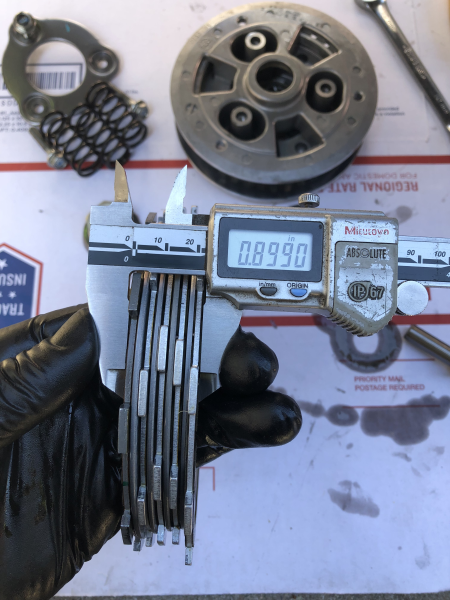
And the basket and pressure plate assembly has .836″ of clearance before it bottoms out when it is removed from the bike.
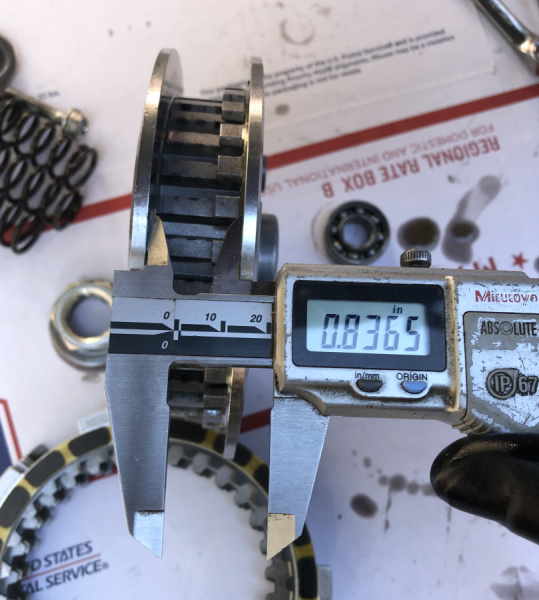
That’s roughly .063″ of clutch wear that you should have before the pressure plate will bottom out and your clutch will slip and you’ll need new plates. The problem here is that when you install the clutch in the bike with the OEM pull rod, the pull rod actually bottoms out on the input shaft long before the pressure plate bottoms out. So the pull rod bottoms out with only .875″ of clearance. That means that instead of the .063″ of clutch wear that you should have, you only get about .024″ before the pull rod bottoms out and your clutch will slip!
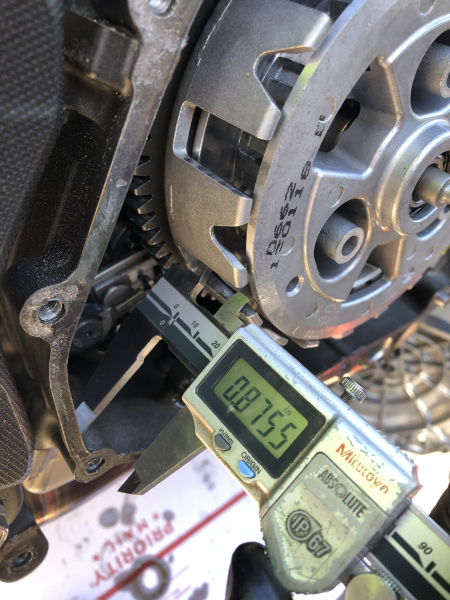
Kawasaki knows about this issue and supposedly the 2020 bikes will have a modified pull rod from the factory (See Below for 2020 Update!). But if your bike is a 2018-2019 and your clutch begins to slip, you can replace the OEM pull rod with our Ninja400R Race Spec modified pull rod (which has been machined down with the necessary extra clearance) and get another .040″ of wear from your clutch plates before they will need to be replaced.
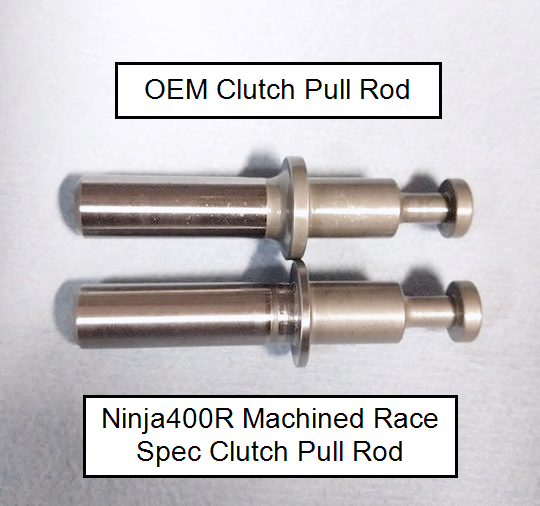
UPDATE
2020+ Kawasaki Pull Rod and Bearing Updated!
UPDATE 4/22/2020, we overlooked it before but have now confirmed exactly what Kawasaki changed for 2020. For 2020+ model year bikes, Kawasaki has replaced both the pull rod and pressure plate bearing with new part numbers.
2020 bikes STILL have the rest of the issues and STILL benefit from fixing the rest of the issues!
At first glance the pull rod appears the same, since the flange is the same thickness, but under closer inspection, the pull rod is shorter from the bottom of the flange to the top of the T by 1mm. This alone doesn’t change anything, but they also changed the pressure plate bearing from an 8mm bearing to a 7mm bearing, increasing clearance by 1mm. Since the clearance issue we addressed with our modified pull rod was an interference between the input shaft, the pull rod, and the bearing, any of these 3 parts could be modified to solve the clearance. We chose to modify the pull rod as it was a simple change to one 1 part, but Kawasaki has solved the same problem by using a thinner bearing and then shortening the pull rod by the same amount so that clutch cable adjustment isn’t affected. Two different solutions to the same problem. However, now that new OEM 2020 parts are available and inexpensive, we will be discontinuing our Race Spec modified pull rod and you can now purchase the updated 2020 OEM parts for your 2018-19 directly from us and save yourself some money! There is no additional labor or tools necessary to install the 2020+ bearing since it is not pressed in. It falls out easily when the pressure plate is removed.
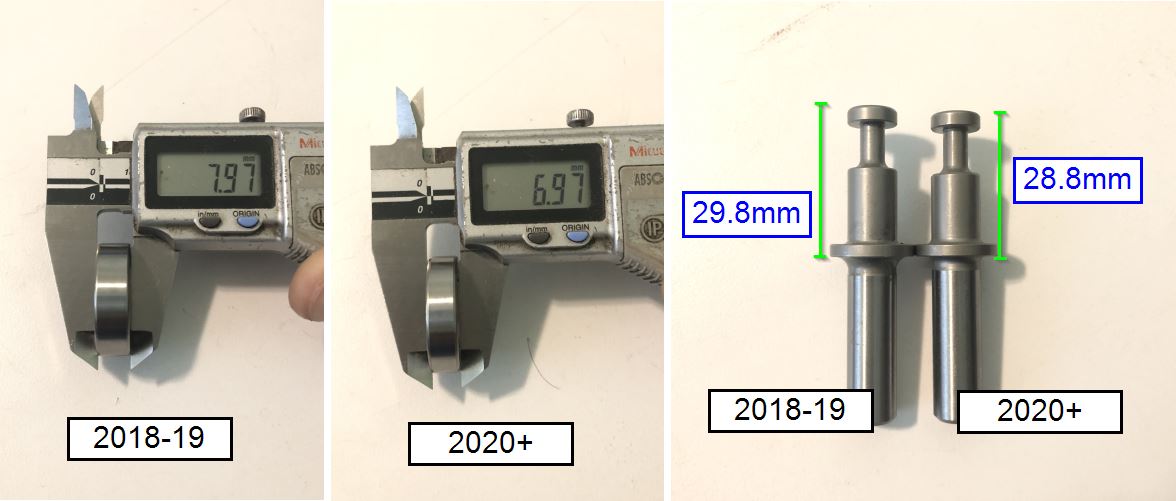
Another tidbit of information regarding the clutch wear and clearance: The OEM clutch pack uses 2.0mm thick steel plates. There are 1 narrow and 3 wide plates in the pack. Kawasaki also has available 1.6mm and 2.3mm thick steel plates for the 3 wide plates (which we have available for sale here). You can increase the clutch pack thickness by replacing the 3 wide 2.0mm plates with 2.3mm thick plates, or a combination of 2.0mm and 2.3mm thick plates. As you increase the thickness of the entire clutch pack, you also increase the amount of clutch wear that is available before the basket or pull rod will bottom out. This can extend the life of your clutch even more, but there is a trade-off of this. As you increase the thickness of the clutch pack, you pre-load the clutch springs more, which reduces the amount of slipper effect you will get, and you remove available adjustment from the clutch cable. If you replace all 3 2.0mm plates with 2.3mm plates, your clutch will barely slip at all, even under hard deceleration, and your cable adjuster will likely be all the way at the end of the adjustment, so pay attention and test it out if you want to try this.
Joined
·
798 Posts
I know this article. Then again, not saying it's soild a 100%, but they themselves write it all happens in regarding to fast acceleration. My point being, it's not a problem to ride this bike with the orignal models (and the new ones too, as I understand this 1mm really doesn't solve anything) for tens of thousands of kilometers without facing an issue. It's not a problem as well to wear our the clutch in your first ride. It all depend on the rider.They updated it because there is a design flaw.
Norton write up below:
Problem #1, My clutch is slipping when I accelerate!
- Solution for OEM clutch: Install Heavy Duty Barnett Clutch Springs and Friction Plates, Ninja400R Cable Spring Kit, and Ninja400R Race Spec Modified Clutch Pull Rod.
- Solution for Yoyodyne slipper clutch: Install Yoyodyne slipper clutch w/ included heavy duty springs and friction plates and Ninja400R Cable Spring Kit.
Definitely the most common issue with the Ninja 400 is that the clutch “wears out” and starts slipping during acceleration with very low miles on the bike, typically between 500-2000 miles. There are three problems acting together to cause this issue in essentially every Ninja 400 and Z400. First, the design of the Kawasaki Ninja 400’s slipper clutch uses two sets of ramps on the pressure plate and center boss of the basket. When you downshift and decelerate quickly, the rear wheel tries to spin the engine up, and one set of these ramps slide together, releasing pressure from the clutch plates which allows the clutch to slip. This is the intended “slipper” effect of the clutch. The amount of slip, and how easily the clutch slips, is determined by the spring pressure of the clutch springs that hold the plates together. When you try to accelerate hard, the other set of ramps slams together, holding the clutch tight so it doesn’t slip under hard acceleration.
Unfortunately, when the clutch slips on deceleration, the friction plates will wear slightly as they spin against the steel clutch plates. Kawasaki installed only 3 soft springs to allow the rear wheel to easily force the ramps to slide against each other and disengage the clutch during deceleration. This makes the bike feel very smooth for new riders as the bike decelerates with less engine braking feel than it would normally have. But this also means that the plates are constantly slipping over each other and gently wearing away. The Ninja’s clutch also only has 5 friction plates in it, and 3 of them are narrower than the other 2, with less material. So the Ninja’s plates will wear faster than a bike with more plates or more material. Even the Yamaha R3, which has a lot less power and torque, and doesn’t have a slipper clutch constantly wearing the plates, uses 6 friction plates.
But there is another interesting byproduct of this slipper clutch design. When you pull the clutch lever and then release it to engage the clutch, as the clutch plates start to grab each other, the ramps slide together, forcing the plates together even if you are still trying to feather the clutch. This will cause the clutch to “grab” all at once. So even if you’re trying to be smooth, it’s very difficult to apply a lot of power during a start. This makes the bike incredibly difficult to launch in a race, and forces you to hold the clutch just before the engage point with the plates spinning across each other much longer when launching the bike than you would have to with other bikes. Again, this accelerates clutch wear. *As a side note, slipper clutches with a different design like the Yoyodyne 5 Spring Slipper clutch that we use and recommend, do not suffer from this side affect, and the bike is WAY easier to launch.
So the first part of the solution is to install stiffer Barnett springs in the clutch. Stiffer springs will hold the clutch together on deceleration until a higher force is applied by the rear wheel to slide the ramps together and compress the springs. Less clutch slip is a trade off for less clutch wear and more engine braking. Depending on how much wear is in your clutch, we often recommend replacing the plates with heavy duty Barnett plates at the same time that you replace the springs since you already have the clutch taken apart. The OEM clutch configuration uses 5 friction plates, but 3 of them are narrower than the other 2. The narrow friction plate in the back provides clearance for the OEM judder spring and seat. Judder springs are used to help smooth the transition between the clutch being engaged and disengaged and reduce vibrations that can happen as the clutch engages. They are typically not an essential part of clutch operation. For track use, it’s reasonable to remove the judder springs and replace the narrow friction plate in the back of the clutch pack with a wide friction plate to increase your friction material.
The second half of this problem is simply a design flaw by Kawasaki. The Ninja 400’s clutch pack is roughly .899″ thick when new.
![Image]()
And the basket and pressure plate assembly has .836″ of clearance before it bottoms out when it is removed from the bike.
![Image]()
That’s roughly .063″ of clutch wear that you should have before the pressure plate will bottom out and your clutch will slip and you’ll need new plates. The problem here is that when you install the clutch in the bike with the OEM pull rod, the pull rod actually bottoms out on the input shaft long before the pressure plate bottoms out. So the pull rod bottoms out with only .875″ of clearance. That means that instead of the .063″ of clutch wear that you should have, you only get about .024″ before the pull rod bottoms out and your clutch will slip!
![Image]()
Kawasaki knows about this issue and supposedly the 2020 bikes will have a modified pull rod from the factory (See Below for 2020 Update!). But if your bike is a 2018-2019 and your clutch begins to slip, you can replace the OEM pull rod with our Ninja400R Race Spec modified pull rod (which has been machined down with the necessary extra clearance) and get another .040″ of wear from your clutch plates before they will need to be replaced.
![Image]()
UPDATE
2020+ Kawasaki Pull Rod and Bearing Updated!
UPDATE 4/22/2020, we overlooked it before but have now confirmed exactly what Kawasaki changed for 2020. For 2020+ model year bikes, Kawasaki has replaced both the pull rod and pressure plate bearing with new part numbers.
2020 bikes STILL have the rest of the issues and STILL benefit from fixing the rest of the issues!
At first glance the pull rod appears the same, since the flange is the same thickness, but under closer inspection, the pull rod is shorter from the bottom of the flange to the top of the T by 1mm. This alone doesn’t change anything, but they also changed the pressure plate bearing from an 8mm bearing to a 7mm bearing, increasing clearance by 1mm. Since the clearance issue we addressed with our modified pull rod was an interference between the input shaft, the pull rod, and the bearing, any of these 3 parts could be modified to solve the clearance. We chose to modify the pull rod as it was a simple change to one 1 part, but Kawasaki has solved the same problem by using a thinner bearing and then shortening the pull rod by the same amount so that clutch cable adjustment isn’t affected. Two different solutions to the same problem. However, now that new OEM 2020 parts are available and inexpensive, we will be discontinuing our Race Spec modified pull rod and you can now purchase the updated 2020 OEM parts for your 2018-19 directly from us and save yourself some money! There is no additional labor or tools necessary to install the 2020+ bearing since it is not pressed in. It falls out easily when the pressure plate is removed.
![Image]()
Another tidbit of information regarding the clutch wear and clearance: The OEM clutch pack uses 2.0mm thick steel plates. There are 1 narrow and 3 wide plates in the pack. Kawasaki also has available 1.6mm and 2.3mm thick steel plates for the 3 wide plates (which we have available for sale here). You can increase the clutch pack thickness by replacing the 3 wide 2.0mm plates with 2.3mm thick plates, or a combination of 2.0mm and 2.3mm thick plates. As you increase the thickness of the entire clutch pack, you also increase the amount of clutch wear that is available before the basket or pull rod will bottom out. This can extend the life of your clutch even more, but there is a trade-off of this. As you increase the thickness of the clutch pack, you pre-load the clutch springs more, which reduces the amount of slipper effect you will get, and you remove available adjustment from the clutch cable. If you replace all 3 2.0mm plates with 2.3mm plates, your clutch will barely slip at all, even under hard deceleration, and your cable adjuster will likely be all the way at the end of the adjustment, so pay attention and test it out if you want to try this.
Joined
·
3,859 Posts
She's amazingly elegant.Thank you for the Sade video. 🥰😍🥵
She's one of my favorite singers for some time, has the sexiest voice, an amazing band, and never gets old. 👍
At 3600 miles currently and clutch appears to be going strong so far.
Mine had to be replaced before 3000 miles. I ride very conservatively. After all I am 78 years young and live in Bohol Philippines where the roads and traffic leave little room for playing road racer. I have been riding since I was 14 years old. I was only without a motorcycle for a period of about 5 years in all that time so don't try and sell me the idea that it was my fault.At 3600 miles currently and clutch appears to be going strong so far.
I have also built complete frames and overhauled many a motorcycle.
It cost me almost $100.00 to fix the issue. I didn't try to get it fixed under warranty because of where I live. It is an hour ride to the ferry plus 1 1/2 hour ferry ride to Mactan island plus another 30-40 minutes from there to the closest dealer which I am sure do not have any parts inventory. I wanted to ride NOW not wait for months to get Kawasaki to fix it. Anyone that has any small mechanical ability can replace clutch parts. I got updated parts from Italy in 2019.
21 - 30 of 30 Posts
-
?
-
?
-
?
-
?
-
?
-
?
-
?
-
?
-
?
-
?
-
?
-
?
-
?
-
?
-
?
-
?
-
?
-
?
-
?
-
?
- posts
- 123K
- members
- 9.8K
- Since
- 2017
A forum community dedicated to Kawasaki Ninja 400 motorcycle owners and enthusiasts. Come join the discussion about performance, modifications, classifieds, maintenance, troubleshooting, and more!



